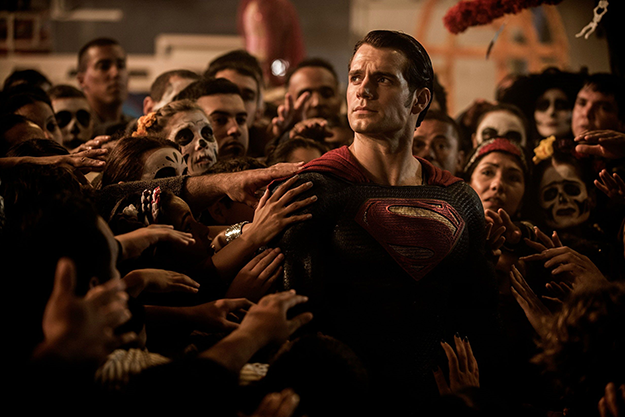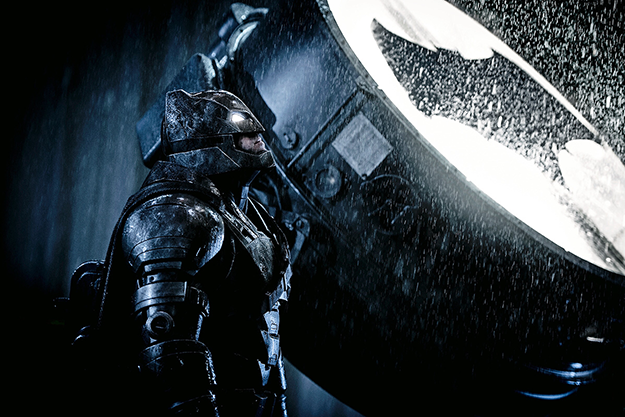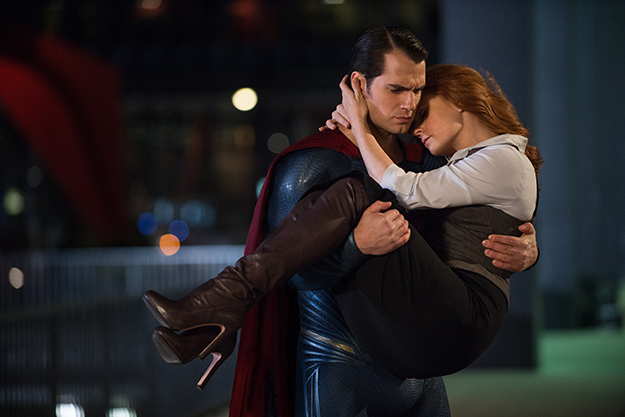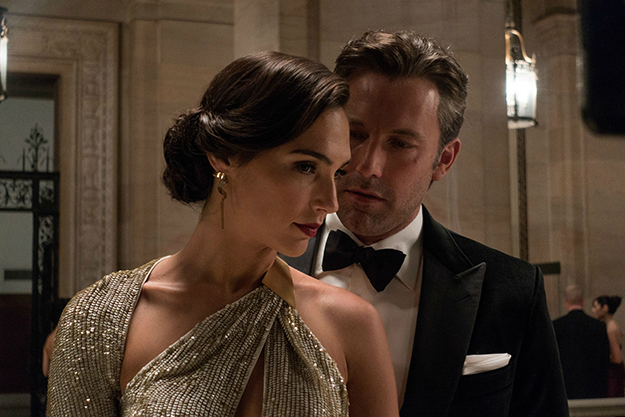Film of the Week: Batman v. Superman: Dawn of Justice
It’s about the most basic hanger there is for a story—the simple question: who’s stronger and fitter? Who would win in a fight? Godzilla or Mothra? Jason or Freddy? Alien or Predator? Kramer or Kramer? Batman v. Superman: Dawn of Justice might have been a lot better if it had simply and honestly tried to serve this reductio ad absurdum-dum premise, but it tries to do a lot more besides, and ends up a crashing bore. I use that term advisedly, bearing in mind Matt Zoller Seitz’s formula for what superhero movies have increasingly boiled down to: “things crashing into other things.”
Batman v. Superman is on one hand a follow-up to Christopher Nolan’s somber Dark Knight trilogy—he and Emma Thomas are on board as executive producers, but the tone here is much less high-minded—and a sequel to Zack Snyder’s 2013 Superman vehicle Man of Steel. I’ve liked some Snyder films—Watchmen struck me as at the very least honorable, and 300 had me roaring, “Tomorrow we breakfast in hell!” with the best of them. I even liked aspects of Man of Steel, which for all its bloated confusion, at least contained a number of images: notably, that strange alien visual technology, in which mineral rods formed pictures in a sort of monumental Stalinist style (I admit, I’m a sucker for any knowing instance of what you might call meta-CGI, as in: just like pixels, but on a bigger scale). On the other hand, Snyder also made one of the creepiest, most idiotic flopbusters of recent years, Sucker Punch, so he’s not entirely to be trusted.
There are a couple of strong images in this film, too, although they’re a little obvious and over-familiar. One is the slow-motion close-up of the breaking string of pearls worn by Bruce Wayne’s mother when she’s killed (yes, that dreary origin tale yet again); the other has young Bruce in a dream sequence falling down a hole before being born aloft by a whirlwind of winged creatures (or as my son promptly labeled it, a “batnado”).
Otherwise, there are next to no images here, just an endless flurry of Picture. The strangest thing about the film is perhaps how the action kicks off in earnest, by way of establishing how its two heroes have cause to fight in the first place. The film begins with a reprise of Man of Steel’s climactic showdown between Superman and General Zod, and with vistas of almighty destruction, as building after building collapses in digital rubble. Bruce Wayne (Ben Affleck) is out amid the chaos, and views it very disapprovingly. Looking up, he sees Superman flash across the sky: instant grudge. It used to be unheard of to start a film with mayhem on this scale, and although it’s no longer a rarity, it’s invariably a bad move: when movies begin the way they used to end, no wonder they have nowhere left to go.
What’s more, the deliberate overlap with Man of Steel makes it feel as if Batman v. Superman doesn’t entirely have a rationale of its own: it feels like an intermediate film, between one thing we’ve already seen and another which is supposedly coming. For—like the increasingly, and forcedly, interconnected Marvel movies with which this film is so evidently in competition—this film is also about setting up expectations for a new franchise. As the subtitle suggests, this is less a movie than a teaser trailer in feature form: Dawn of Justice is about putting a Justice League series in place to compete with Marvel’s revenue-guzzling Avengers titles. (Ironically, the original Avengers comic was itself Marvel’s attempt to launch an all-star team title in the image of DC’s Justice League of America).
BvS also recycles another key DC Comics trope, the perennial “Death of Superman” moment, which seems to raise its head every time the publisher needs a boost in media coverage—as happens so often, there’s always a shard of green Kryptonite available somewhere to make it look as if Clark Kent’s indestructability has met its limits. In this film, a chunk of the miraculous mineral is one of at least two MacGuffins, and it’s pursued by a disconcertingly young Lex Luthor. He’s played by Jesse Eisenberg as a hip but deranged business wiz, somewhere between Mark Zuckerberg and Elon Musk, or perhaps a more shabbily dressed Tony Stark—at any rate, he’s the anti-Bruce Wayne. Eisenberg is good value for a while. He babbles, he twitches, he gibbers, he overdoes it and at least he doesn’t make you cringe like Gene Hackman’s flip Lex in the Christopher Reeve Superman cycle. But it’s never very clear exactly what his agenda is, apart from being a spoilt, power-mad tyke; he comes across most like Clark Kent’s young journo buddy Jimmy Olsen halfway to becoming the Joker.
Overall, you get a sense of terrible waste. Yes, it’s always nice to see actors of the caliber of Holly Hunter (as a skeptical judge) and Jeremy Irons (as Alfred the butler) get to do something—anything!—in these big splashy movies, but human presence here feels surplus to requirements. And that certainly wasn’t true in Nolan’s Batman films, for all their ponderousness. I mean, why does a performer as mesmerizing and complex as Amy Adams (Amy Adams, for goodness’s sake!) need to be flailing around in a woman-in-peril underwater sequence? And the little Clark-and-Lois domestic discussion that takes place while Adams is in the bath is what you’d have to call a Zack Snyder touch, just as Megan Fox washing cars in shorts is the defining mark of Michael Bay’s auteur signature.
The action scenes certainly go like gangbusters—deregulated gangbusters, in which everything’s so speedy and decentered you can’t even locate the gang any more. As for the big central wham-bam between our two heroes, it’s furious and surprisingly violent. Bruce Wayne manages to get on a level footing with Superman by not only using Kryptonite but sporting a big chunky robotic mecha-suit—which, I have to say, seems damnably unsporting of him. Frank Miller’s 1980s reinvention of the Dark Knight set the tone for so much “troubled” comic-book characterization since—and heaven knows, we wouldn’t want to go back to Adam West’s cheery “ZAP! POW!” fighting, let alone his character’s tongue-in-cheek super-decency (remember the 1966 Batman movie in which he can’t dispose of a bomb because some ducks are swimming past?).
But both Bruce Wayne and Clark Kent come across as sullen, unlikeable, and quite vicious bruisers here, and it’s remarkably hard to root for either. The device that’s supposed to make the pair of them seem vulnerable and redeemable is that old chestnut, the traumatic backstory, and the film resolves this matter, and their enmity, in terms so ludicrous that you have to suspect that someone on this production is having a good laugh (not Snyder, who seems to lack any funny bone whatsoever): the two heroes discover that both their mothers were called Martha!
Occasionally, the film—scripted by Chris Terrio and David S. Goyer—seems to stabilize on some level of coherence. I actually like the first half-hour, which zips around episodically, rather like a Bond movie, and actually seems to be heading in a promising direction. Then something entirely inexplicable will happen—such as an entirely self-contained action sequence within a dream, in which Batman appears to be fighting some sort of Nazi storm troopers in a desert. The most disastrous such veering off-track, and the film’s worst failure of narrative nerve, comes near the end, when the narrative is taken over by a showdown between the red-and-blue guy and a huge lumbering green monster emitting bolts of energy, making for a son et lumière as drearily digital as Electro’s in the last Spider-Man pic.
A lot of what doesn’t make sense dramatically is purely conceived as an insider nudge to fans, who will get, and conceivably care, that the film’s other MacGuffin, a set of secret computer files, is designed to introduce famous-ish characters we’ll meet in a later film (oh look, it’s Aquaman! You know, Aquaman). Of these, the only one who’s deserving of headline coverage, and who gets some decent screen time, is Wonder Woman, played by Gal Gadot, an Israeli actress with quizzically angular features. She first appears as a mystery femme in a variety of plunging cocktail dresses, eyed up at various parties by Clark Kent; these scenes introduce a welcome touch of another genre entirely, Mission: Impossible-style techno-espionage. But as the hard-hitting, independent feminist superheroine we’ve vaguely been promised in the build-up to the film, Gadot’s scowling amazon isn’t nearly as convincing as Rebecca Ferguson was in the last M:I episode (for one thing, Snyder makes far too much gloating capital of her thighs in the action scenes).
Every time I review a superhero movie these days, the teenage Marvel obsessive that I once was always nudges me to protest that honestly, on some level, I really, really want to enjoy one of these things, but it rarely happens (I didn’t mind Ant-Man, though). Yet I’ve never felt so bored, so brutalized, or just given so little to work with as in this cacophonous, joyless slurry, which out-bombasts even the most meaninglessly bombastic genre entries we’ve seen to date. At the end of the film, Affleck’s Bruce Wayne, talking about how it’s time for good guys to wise up and raise their moral game, ruefully mutters the words: “We can do better. We will. We have to.” Maybe Snyder does have a sense of humor after all.
Jonathan Romney is a contributing editor to FILM COMMENT and writes its Film of the Week column. He is a member of the London Film Critics Circle.











